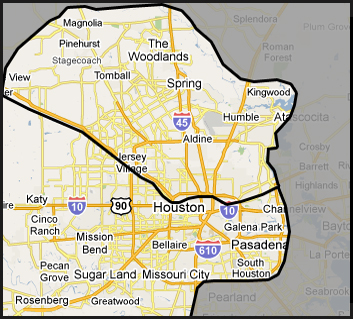Basics of Electricity for Stafford
are here to meet your every need.
Electron - Electrons are how energy is transferred through a conductor such as the wiring in your home or building. Electrons are tiny negatively charged particles that orbit the positively charged nucleus of atoms. Electrons are extremely small so as to only account for a very small portion of the overall mass of the atom.
Potential Difference - For your electricity in your home or building to work there needs to be a difference in electrical potential, or voltage, from one point in a circuit to another. The voltage rating on a battery describes the potential difference between its terminals. Much like how lightning flows through the atmosphere electricity is always seeking a ground. This is how all the appliances, electronics, and lights work in your building by coming into the electrical service supplied to the appliance and then to ground.
This is also how you can receive an electrical shock by completing the circuit from the power lines, or plug in, to ground.
Volt (V) - Voltage a unit of measure is the driving force, or potential difference behind electron flow, and hence the force behind the flow of current in an electrical circuit. Energy always flows from an area of high energy to low energy or from hot to ground.
If you think about water flowing through a pipe, you can think of the pressure behind the water as voltage, and the amount of water flowing through the pipe as current. The difference between water and electrons are, that when water has more pressure behind it, it travels faster, electrons will always travel at the same speed through a wire regardless of energy behind them.
Resistance - Resistance is the ability of a circuit to impede the flow of electrons, or current flow. Everything has some resistance associated with it, even metal wires. Some of these resistances are so small that we will ignore them in most cases. Electric motors use the resistance, of the motor, to create magnetic fields which in turn make the motor rotate.
Ohm (Ω) - The unit of measure for a circuits resistance to current flow.
Resistor - Resistors have resistance, and their primary function is to add resistance to a circuit.
Current - The flow of electrons in a circuit, measured in Amps. The more voltage you have in a circuit, the more current flow you have, and the higher resistance in a circuit, the less current flow you have. This is Ohm's Law.
Something that needs to be remembered is that volts don't kill you, it's current. A 100,000 volts can shock you and not die. When you shock someone with static electricity, that's many thousands of volts, but it's a low current flow.
You can normally handle circuits under 13 volts without getting zapped because your skin's resistance. However, if you have a break in your skin, or get it wet, that resistance is dramatically reduced and you can get zapped. An example of this is to put a nine volt battery on your hand, then try it on your wet tongue.
As little as 1/1000th (1 milliamp) you can feel, 1/100th (10 milliamp) can cause your muscles to contract, and 1/10th of an amp (100 milliamp) across the heart can kill you.
Ohm's Law - Current is directly proportional to the voltage in a circuit, and inversely proportional to the resistance of the circuit. We express this as an equation: This equation is a verygood one to remember. You will use it often when working with electrical circuits.
Ampere, Amp (A) - The unit of measure of current flow in a circuit.
Direct Current (DC) - Direct positive and negative sides never reverse. A battery only produces direct current when connected to a circuit (the circuit can change the DC into AC).
Alternating Current (AC) - Alternating current means the current flow goes one way and then reverses its direction at regular time interval. This happens because one terminal is negative and the other is positive for a while, then they switch from being negative to positive and from positive to negative.
In the US, household AC is 60Hz which means current switches back and forth 60 times in one second. The human body has bio-electrical reactions that control such things as muscles, and the heart beating, and they operate at a frequency very close to 60 Hertz. This makes AC even more dangerous than DC because one shock could throw off your biorhythms and could trigger a heart attack within hours. A person that has been shocked for by AC should be watched for a few hours to make sure he doesn't have a heart attack.
CPR alone may be enough to help someone who has had a heart failure due to electrical shock. Even if CPR brings someone back, if it was caused by a shock or not, they must go to a hospital.
Battery - Batteries convert chemical energy into electrical energy. Multiple battery cells can be connected in series to increase the voltage of the circuit. All batteries have some internal resistance, which means some batteries are better at high current flows than others.
Conductor - A material in which current is able to flow through easily. Most metals make good conductors, some better than others, silver being the best in normal conditions.
Super-conductors have nearly no resistance to current flow, but they often have to be super-cooled to work and are very expensive.
Insulator - An insulator is a material that does not conduct current very well. It is the exact opposite of a conductor. The rubber around wires is an insulator. Glass is also used as an insulator.
Watt (W) - The measurement of power in a circuit, as determined by multiplying volts times amps: A Kilowatt is 1,000 watts. A Watt-Hour is the number of watts used over an hour. You can think of Watt as measuring the speed you're using power, like MPH (miles per hour), and a Watt-hour as the distance you've actually traveled over that time.
Short Circuit - Current wants to take the path of least resistance. If there is a path of very low resistance, current will want to flow that direction more than any other. When there is a path of very low resistance back to the power source (which isn't supposed to be there), we call this a short circuit. A short circuit can cause a fire.
Fuse - A fuse is a device that, if a current level is exceeded, the wire, or substance inside of the fuse, will heat up and then melt, breaking the electrical connection.
There are fast and slow blow fuses. Fast blow fuses are used to protect circuits from short circuit conditions. Slow blow fuses don't blow right away when they have reached their current rating. Slow blow fuses are used with motors and other components that have high starting currents.
The idea behind a fuse is that fuse will blow (melt) before something else in your circuit melts, catches fire, or blows up.
Fuses are electrical safety devices and should never be jumped out with wire, foil, or any other metal. They are used to protect other electrical components in a circuit and to prevent electrical fires. Only replace a fuse with a fuse of the same type and rating.
Circuit Breaker - A Circuit Breaker provides overload protection. They are slower acting than a fuse. Circuit breakers are electro-mechanical devices which will break a circuit if too much current is flowing through a circuit for too long. Unlike fuses, they can be reset by flipping a switch you don't need to replace them unless they go bad.
All houses built today use circuit breakers rather than fuses. If your house still uses fuses, the wiring is old and you could be at risk for an electrical fire.
Some smaller circuit breakers have a pot of soft solder that melts at a specific temperature. If the pot gets too hot due to excessive current flow, the solder will soften enough to allow a plunger to pop out. To reset it, push the plunger back in. The end of the plunger you push looks like a button.
When a household circuit breaker trips, the circuit breaker will be in a position that's not quite in the off or on position. To reset, you need to take the breaker switch first to off, and then back to on. Taking it to off resets the trip mechanism and allows the breaker to be closed. If your circuit breaker continues to trip then you should contact an electrician immediately.
Generator - A device that generates electron flow through moving a conductor through a magnetic field.
The amount of voltage induced in the generator coil is directly proportional to the strength of the magnetic field, and the speed at which the magnetic field is changing or moving through the conductor.
Transformer - Transformers are able to step up, or step down AC voltages through magnetic field interactions. They are also able to isolate an AC circuit from other AC circuits.
Ground - Ground is considered at zero potential. There are two types of grounds: a circuit or chassis ground, and an earth ground. An earth ground means that the ground is somehow physically connected to the ground you are standing on. A circuit or chassis ground just means that there is a wire or connection that is connected to the case that the circuit is housed in.
The third prong on your electrical outlet (US/Canada) is an earth ground (if it isn't, somebody wired your house wrong). The earth ground is often connected to the metal case of the machine. Electricity takes the path of least resistance, so, if there is a good earth ground to a metal case, electricity would rather flow through the grounding wire instead of you. The grounding wire in a house is either green or bare copper.
If you don't have three prong outlets in your house, you need to have a licensed electrician come out and rewire your house. He'll also put in a device called a GFCI, or Ground Fault Interrupter. GFCI's will break the circuit if there is a ground fault like what would happen if you drop something electrical in a tub.








